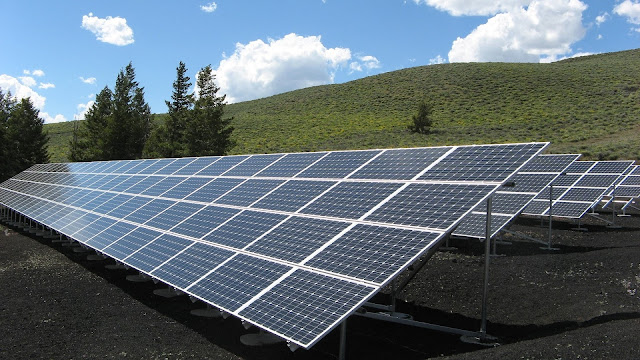NON-CONVENTIONAL SOURCES OF ENERGY ऊर्जा के गैर-परम्परागत स्त्रोत)
 |
| ऊर्जा के गैर-परम्परागत स्त्रोत |
One of the major problems in the technological uplift of any country is the energy crisis. The traditional sources are on the brink of being exhausted. Therefore, alternative sources have to be looked for, in particular the inexhaustible reservoir of energy that is under the surface of the earth, and the solar energy. Availability of the appropriate kind of energy in adequate quantity is crucial to development both for achieving higher productivity and improving the quality of life through mechanization.
The industrial revolution which changed the complexion of Western countries was based on cheap fossil fuel supply. Developing countries like India with scarcity of fossil fuel have all the more reasons to scek for other energy sources with emphasis on renewable sources.
All the different sources of energy can be divided into two main categories :
(i) Renewable sources of energy,
(ii) Nonrenewable sources of energy.
The sources of energy which are being replenished continuously in nature and are inexhaustible, are called renewable sources of energy. Because it wood is cut from forests for heating purposes, more wood will grow in the forest. So, the loss of wood by cutting is adequately compensated for by nature. The important examples of renewable sources of energy are : Wood, Water falls (hydropower); Geothermal power - the power generated by the heat of the earth: the solar energy, the wind energy; tidal energy: plants: vegetable refuse and gobar gas. The renewable soures of energy are also called nonconventional sources of energy.
Those sources of energy which have accumulated in nature over a very long span of time, and cannot be quickly replenished are called nonrenewable sources of energy, for example coal, which accumulated in the interiors of the earth over a long period of time, and if gets exhausted, it cannot be produced quickly in nature.
The important nonrenewable sources of energy are : coal; natural gas; petroleum (crude oil); and uranium (for nuclear energy). The nonrenewable sources are also called conventional sources of energy.
Renewable Sources of Energy:
Some of the important renewable sources of energy also called nonconventional sources of energy, are:
(i) Solar Energy
(ii) Biomass
(iii) Biogas
(iv) Wind Energy
(v) Tidal & Wave Energy
(vi)Geothermal Energy
Solar Energy
Solar Energy
Although conventional sources of energy will soon exhaust, the Sun, an inexhaustible source of energy, will last us till eternity. It is burning up at the rate of four million tons/second and pouring itself out into space in the form of heat, light, X-rays and other forms of energy. In a few minutes it sends out as much energy as we require in a year's time. This energy can be used directly, using several energy devices such as solar cabinet driers, solar water heater: solar cooker; solar timer; wood seasoning kilns, and photovoltaic cells. The indirect utilization methods of solar energy include hydro. wind.
Biomass
The storage of solar energy and its utilization require large areas, especially for thermal systems. The Research and Development effort is in pursuit of inexpensive methods of collection and storage of this energy. Biomass
Man since ancient times has relied on biomass plant material or vegetation, especially as a source of fuel or energy which is necessary for cooking and heating. The majority of rural poor in developing countries continue to depend on the energy from biomass. Unfortunately the forest resources are far from adequate to meet their demands. It is imperative to enhance production of biomass, but because of inadequate availability of land, the use of wastelands as well as aquatic sources for biomass has become necessary. This brings into focus the need for a variety of fast growing trees and plants, both terrestrial and aquatic. There is also the possibility of utilizing under exploited plants and tapping the growth potential of woods.
Biogas
In the biogas floating dome apparatus a charge of human and cattle wastes is fed. Because of a chemical reaction that begins to take place in absence of oxygen, a mixture of methane and carbondioxide is released. This mixture of gases is called biogas, which is used for cooking and lighting purposes. This technology of biogas generation has the ability for simultaneously generating fuel and fertilizer. The refuse, of the biogas dome is called 'sludge'. It is a very good fertilizer. The utilization of human and cattle waste in this manner keeps the village environment neat and clean.
India has done pioneering work in the field of biogas generation, by developing and propagating the floating dome shaped model , mentioned above. It is adopted by the Khadi and Village Industries Commission (K.V.I.C.).
Wind Energy Systems
India has a very high potential for wind energy utilization. Several high wind density areas have been identified. Considerable amount of work in tapping this resource is in progress. Several models of wind pumps have been developed and installed throughout the country. Regional wind energy test stations for technology adaptation, performance evaluation, testing and training, have been set up by the Department of Nonconventional Energy Soures, Government of India, with a view to encouraging development and adaptation of wind pumps and small battery chargers. A good deal of work to convert wind energy into power has been done, and a number of systems has been set up at Puri (Orissa), Okha (Gujarat), Tuticorin (Tamil Nadu) etc.
Tidal and Wave Energy
Tides are generated twice a day by the gravitational attraction between the Earth and the Moon. Water at high tides is collected in artificial basins, and is allowed to escape at low tides. The escaping water is used to drive reversible water turbines; and in turn, electrical generators. Generators can be run during high tide and low tide.
Wave energy is difficult to collect because of fluctuations in frequency and amplitude, and as such, at present, it is at an experimental stage.
Geothermal Energy
This energy comes out of the molten interiors of the earth towards its surface. Since the different layers of the earth are not uniform, there are numerous hot spots just below the surface. When ground water comes in contact with the hot rocks, it is changed into steam. A well, drilled through these locations, causes the steam to escape to the surface, where the energy (heat) can be utilized for power generation.
In India, Geothermal resources are known to exist along the west coast in Ladakh and in parts of Himachal Pradesh.
As we know, today, the energy consumption threatens to out pace the available production, it is vital for the existance of mankind that the new technologies should aim at harnessing energy sources of greater potentialities 0 the sun, the wind and the ocean and the great repository of energy the womb - of the mother earth !
हिन्दी सारांश- इस पाठ में ऊर्जा के गैर-परम्परागत स्रोतों के विषय में बतलाया गया है। युग में मशीनों एवं कारखानों को चलाने के लिए ऊर्जा की आवश्यकता होती है पर यह पर्याप्त रूप में नहीं है अतः यह आज के युग की एक विशेष समस्या है । अत्यन्त आवश्यक होने के कारण इसका इतना उपयोग किया जा रहा है कि अब इनके स्रोत कम होते जा रहे हैं। यह आज का सबसे बड़ा संकट है। यह सभी जानते हैं कि औद्योगिक देशों की प्रगति कल-कारखानों के कारण है जिसमें ऊर्जा का अत्यधिक प्रयोग किया गया है । अतः अब यह आवश्यक होता जा रहा है कि ऊर्जा के अन्य स्रोतों की खोज करें ताकि हमें निरन्तर ऊर्जा प्राप्त होती रहे। विकासशील देशों में आज के
Non-Conventional Sources of Energy 219
बात पर बहुत अधिक जोर दिया जा रहा है। भारत में भी ऐसा ही है ।
ऊर्जा के समस्त स्रोतों को निम्नलिखित दो मुख्य वर्गों में बाँटा गया है (i) वह ऊर्जा जिसका नवीनीकरण किया जा सकता है।
सम्भव है, जैसे(ii) वह ऊर्जा जिसका नवीनीकरण नहीं किया जा सकता है। प्रकृति में ऊर्जा के अनेक स्रोत हैं जो कि पहले वर्ग में आते हैं क्योंकि उनका नवीनीकरण यदि जंगल से अधिक लकड़ी काटी जाए तो उसे उगाया भी जा सकता है। इस वर्ग में लकड़ी, झरने आदि आते हैं। इन्हें ऊर्जा के गैर-परम्परागत स्रोत भी कह सकते हैं। प्रकृति के वे स्रोत जिन्हें हम शीघ्रता से पूरा नहीं कर सकते हैं, वे दूसरी श्रेणी के स्रोतों के अन्तर्गत आते हैं, जैसे कोयला, प्राकृतिक गैस, यूरेनियम आदि । ये ऊर्जा के परम्परागत स्रोत हैं पर ये सीमित हैं और इनका प्रयोग प्रचुर मात्रा में करने से इनमें कमी आ सकती है। ऊर्जा के प्रमुख गैर-
परम्परागत स्रोत निम्नलिखित हैं -
(i) सौर ऊर्जा (Solar Energy) - सूरज (सूर्य) ऊर्जा का एक विशाल स्रोत है। यह शायद अनादिकाल तक चल सकता है । यह चार करोड़ टन की गर्मी रखता है तथा संसार को धूप, प्रकाश आदि प्रदान करता है । इसका प्रयोग पानी के हीटर, सोलर कुकर आदि के लिए किया जा रहा है। इसके भण्डारण के लिए बड़े चौड़े स्थानों की आवश्यकता होती है।
(ii) बायोमास (Biomass) - प्राचीनकाल में इसका प्रयोग अधिक था क्योंकि मानव जीवन वनस्पति तथा ईंधन पर निर्भर था । आज भी अधिकतर ग्रामीण क्षेत्रों में ऊर्जा के इसी प्रकार का प्रयोग किया जा रहा है लेकिन दिन पर दिन जंगल कम हो रहे हैं । अतः उनके विकास की ओर अधिक ध्यान दिया जाना चाहिए।
(iii) बायोगैस (Biogas)- यह रासायनिक प्रतिक्रियाओं के फलस्वरूप उपलब्ध होती है । यह एक प्रकार से गैसों का मिश्रण (mixture) होता है। इससे ईंधन एवं उर्वरकों को उत्पन्न किया जा सकता है। इसमें मानवों एवं पशुओं का गोबर भी प्रयोग किया जा सकता है । भारत में बायोगैस के क्षेत्र में अग्रणी कार्य किया गया है । इसका अधिकतर कार्य खादी एवं ग्रामीण उद्योग आयोग द्वारा किया जा रहा है।
(iv) पवन ऊर्जा (Wind Energy)- भारत में इसके उपयोग की अधिक संभावनाएँ हैं। अनेक ऐसे स्थानों का चयन कर लिया गया है जहाँ पर पवन पम्प लगाये गये हैं। भारत का गैर-पारम्परिक ऊर्जा विभाग इस क्षेत्र में काफी काम कर रहा है। पवन ऊर्जा के कार्य संचालन हेतु कुछ संस्थान पुरी (उड़ीसा), ओखा (गुजरात) तथा तूतीकोरन (तमिलनाडू) में खोले गये हैं।
(v) समुद्री ज्वार एवं लहरों से प्राप्त ऊर्जा (Tidal and Wave Energy)- पृथ्वी एवं चंद्रमा के गुरुत्वाकर्षण के कारण समुद्र में लहरें उठती हैं। इस पानी को इकट्ठा कर टर्बाइन्स को चलाया जाता है जिससे ऊर्जा पैदा होती है । यद्यपि यह कठिन कार्य है पर अनेक स्थानों पर इसका प्रयोग किया जा रहा है।
(vi) भू-तापीय ऊर्जा (Geothermal Energy) - यह पृथ्वी के पिघले हुये लावा से प्राप्त होती है। पृथ्वी की सतह सभी जगह समान नहीं होती अतः अनेक स्थान नीचे गर्म होते हैं, उन्हीं स्थानों पर ड्रिल (छिद्र) कर भाप प्राप्त की जाती है। भारत में यह कार्य लद्दाख के पश्चिमी सिरों तथा हिमाचल प्रदेश के कुछ भागों में चल रहा है। -
Thanks for you support me.....



